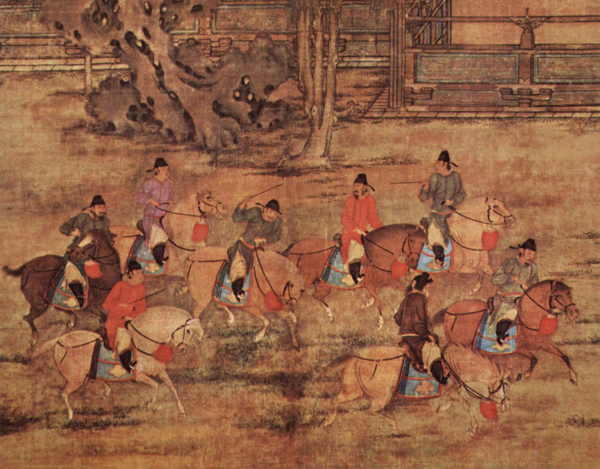Towards the end of the Tang Dynasty (618-907), much of China’s territory was controlled by powerful military governors known as jiedushi. When the Tang government found itself greatly weakened after the brutal Huang Chao Rebellion (874-884), one such military man named Zhu Wen decided to take matters into his own hands. Zhu had become a jiedushi by betraying Huang Chao and helping the Tang Dynasty. As the old saying goes, a leopard never changes his spots! In 907, he forced the reigning Emperor Ai to abdicate and took his place, establishing the Later Liang Dynasty (907–923) and officially putting an end to the Tang Dynasty.

Zhu controlled much of northern China, but some parts of Shaanxi, Hebei, and Shanxi province remained in the hands of rival kingdoms, as did all of southern China. In time, a tenuous relationship developed between Zhu Wen and Li Keyong, the leader of an ethnic group known as the Shatuo Turks. Li controlled Shanxi province under the State of Jin and, when he passed away, he was succeeded by his son, Li Cunxu. In 923, Li Cunxu was able to conquer the Later Liang and established the second of the five dynasties, known as the Later Tang (923–36). Like a game of musical chairs, China’s northern territory would find itself passed from one dynasty to the next!
Although the Later Tang emperors were ethnically Shatuo, they were highly Sinicized. They chose the name “Tang” in an attempt to legitimise themselves as the rightful restorers of the Tang Dynasty, as they shared the same last name as the Tang royal family. In a bold move, Li Keyong established friendly ties with the Khitan people, who were also an ethnic group hailing from the northern steppe. It was this powerful alliance that figured greatly in the success of the Later Tang Dynasty.
However, the Later Tang only lasted a brief thirteen years, predominantly due to the fact that relations between them and the Khitans quickly soured. When Li Cunxu was killed during a rebellion in 926, he was succeeded by Li Keyong’s adopted son, Li Siyuan. It was from this point onwards that internal struggles, coupled with the aggravation of the Khitans, began to cripple the dynasty. In 936, Li Siyuan’s son-in-law, Shi Jingtang, allied with the Khitans and overthrew the Later Tang, establishing the Later Jin Dynasty (936–947) in its stead.
By this time, the Later Tang Empire had grown considerably since it overtook the Later Liang. This meant that the Later Jin not only controlled the Later Liang’s northern territories, but also inherited modern-day Shanxi province, Shaanxi province, and the area surrounding the city of Beijing. The only major northern territory outside of their reach was a region known as the Sixteen Prefectures, which covered the present-day municipalities of Beijing and Tianjin and the provinces of Hebei and northern Shanxi. This crucial region was under the sway of the Liao Dynasty[1] (916–1125), which was ruled by the mighty Khitans.
As time went on, it became increasingly more obvious that the Later Jin Dynasty was simply a puppet to the Liao Dynasty. The derision that the Later Jin faced as a result of this proved too much for Shi Jingtang’s successor, Shi Chonggui, who decided to openly defy the Liao and prove his dynasty’s independence. His plan backfired horribly, as the Liao invaded his territory in 946 and completely destroyed the Later Jin Dynasty. Talk about swift punishment! However, the Khitans were embroiled in a succession crisis when their emperor unexpectedly died almost immediately after his victory over the Later Jin. This created a power vacuum, as the Later Jin no longer existed but the Liao Dynasty was in no position to effectively annex their territory.
This set the scene for a military governor named Liu Zhiyuan to seize the Later Jin Empire and establish the Later Han Dynasty (947–951). It would be the shortest lived of the Five Dynasties, and among one of the shortest regimes in Chinese history! This was in part due to the fact that Liu Zhiyuan died just one year after founding the dynasty, and was succeeded by his teenage son. In 951, a military man named Guo Wei staged a coup, overthrew the Later Han, and established the Later Zhou Dynasty (951–960). However, the Later Han royal family were not going to be beaten that easily! They returned to their original stronghold of Shanxi province and founded the Kingdom of Northern Han (951–979), which came to be known as one of the Ten Kingdoms.
Meanwhile, Guo Wei proved to be an able, organised, and energetic leader who championed many reforms designed to help the lower classes. His unfortunate and untimely death in 954 was a serious blow to the dynasty. He was succeeded by his adopted son Guo Rong, who also proved to be a capable ruler and military strategist. Unfortunately, much like his father, he fell ill during a military campaign and suddenly died in 959. His seven-year-old son was placed on the throne, marking the decline of the dynasty. Not long thereafter, Zhao Kuangyin usurped the throne and declared himself Emperor Taizu of the Song Dynasty (960-1279).
Like a relay team, each of the Five Dynasties had gone one step further towards unifying the country. The changes that had taken place during this period heralded the end of aristocratic power, ushering in a new bureaucratic era that would permanently transform the political landscape. However, it was the Song Dynasty that finally put an end to the Five Dynasties and Ten Kingdoms Period by reuniting northern and southern China. The Song Empire, though smaller than the preceding Tang Empire, provided a welcome stability that China’s citizens had not enjoyed for over 50 years.
[1] Please note that the Liao Dynasty changed its name periodically throughout its reign. Between the years of 916 to 974 and 983 to 1066 it was known as the Khitan Dynasty, but from 974 to 983 and from 1066 onwards it was the Liao Dynasty.